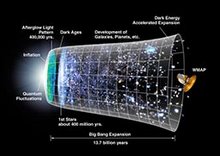 Pic1: Remodelling of Big Bang showcasing big bang to birth of first star to galaxies to universe expanding at exponential rate due to dark matter/dark energy
Pic1: Remodelling of Big Bang showcasing big bang to birth of first star to galaxies to universe expanding at exponential rate due to dark matter/dark energyThe cosmic portrait–taken by NASA’s Wilkinson Microwave Anistropy Probe–shows the universe as it looked 380,000 years after the big bang, some 200 million years before any stars or galaxies had formed.
In Layman's words: "If you stand on top of Empire State Building and observe the ground, what you see by 7th floor is a time-frame by which the stars-galaxies were born, going down (going back to the past) what you see just 2" above ground is the image of baby universe (around 380,000 years old from big bang)
The probe imaged the entire sky for a full year, producing a detailed picture of the cosmic microwave background, the afterglow of the big bang. The incomparable heat of the big bang has cooled to a mere 2.73 degrees above absolute zero, but WMAP can detect temperature variations of millionths of a degree. Within these variations were the seeds that later grew into stars, galaxies and clusters of galaxies that populate the universe today.
In other findings, WMAP pegged the age of the universe at 13.7 billion years, with an error margin of only 1 percent. It also measured the contents of the universe to consist of 4 percent ordinary matter (which make up people, planets and stars), 23 percent of an unknown and unseen material called dark matter, and 73 percent of a mysterious dark energy that acts in opposition to gravity.
 Pic2: A cosmic history, illustrated above, shows the first light of the universe–the afterglow of the big bang, which the WMAP observed. This light emerged 380,000 years after the big bang. Patterns imprinted on the light, which are shown in the first ellipse, encode the events that happened only a tiny fraction of a second after the big bang. In turn, the patterns are the seeds of development for galaxies we now see billions of years after the big bang.
Pic2: A cosmic history, illustrated above, shows the first light of the universe–the afterglow of the big bang, which the WMAP observed. This light emerged 380,000 years after the big bang. Patterns imprinted on the light, which are shown in the first ellipse, encode the events that happened only a tiny fraction of a second after the big bang. In turn, the patterns are the seeds of development for galaxies we now see billions of years after the big bang.The light we see today, as the cosmic microwave background, has traveled over 13 billion years to reach us. Within this light are infinitesimal patterns that mark the seeds of what later grew into clusters of galaxies and the vast structure we see all around us today.
Patterns in the big bang afterglow were frozen in place only 380,000 years after the big bang, a number nailed down by this latest observation. These patterns are tiny temperature differences within this extraordinarily evenly dispersed microwave light bathing the universe, which now averages a frigid 2.73 degrees above absolute zero temperature. WMAP resolves slight temperature fluctuations, which vary by only millionths of a degree.
Theories about the evolution of the universe make specific predictions about the extent of these temperature patterns. Like a detective, the WMAP team compared the unique "fingerprint" of patterns imprinted on this ancient light with fingerprints predicted by various cosmic theories and found a match.
Pic3: WMAP
Note: WMAP is named in honor of David Wilkinson of Princeton University, a world-renowned cosmologist and WMAP team member who died in September 2002.
Resources:
1) http://science.nasa.gov/headlines/y2003/11feb_map.htm
2) http://chronicle.uchicago.edu/030220/probe.shtml


No comments:
Post a Comment